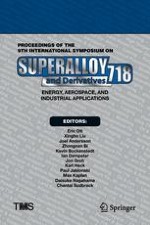2018 | Book
Proceedings of the 9th International Symposium on Superalloy 718 & Derivatives: Energy, Aerospace, and Industrial Applications
Editors: Eric Ott, Prof. Xingbo Liu, Dr. Joel Andersson, Dr. Zhongnan Bi, Dr. Kevin Bockenstedt, Dr. Ian Dempster, Dr. Jon Groh, Dr. Karl Heck, Paul Jablonski, Dr. Max Kaplan, Dr. Daisuke Nagahama, Ph.D. Chantal Sudbrack
Publisher: Springer International Publishing
Book Series : The Minerals, Metals & Materials Series
